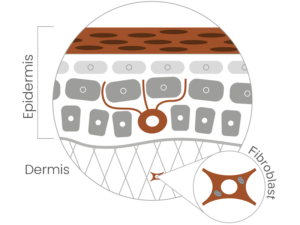Melanocytes: what they are and how they work
Melanocytes are cells that sit in the dermis and hair follicle and produce a pigment called melanin that dyes the hair, eyes and skin. Their shape resembles a polyp with a nucleus and several arms called dendrites.
In the different skin phototypes this cell is present in varying proportions and also the pigment it produces changes in quantity and quality: in blondes melanin is scarce and barely golden, in redheads it is reddish and poorly distributed while, at the opposite extreme, in phototype 6, the darkest of all, it is abundant and almost black.
In the albino subjects, this substance is, on the contrary, totally absent, so that the hair is white, the iris reddish and the skin absolutely devoid of colour.
The function of melanin is to protect our skin and our entire body from UV radiation and, as with all biological functions, the cells that produce it become less active or even dysfunctional over time.
The formation of spots, freckles or other dyschromia is nothing more than an alteration of the melanocytes, which instead of distributing the pigment correctly and evenly, concentrate it in certain areas, giving rise to different types of hyperpigmentation.
The MyCli approach
Counteract the already formed spot, through inhibitors of melanosome travel to the surface;
Inhibit the enzyme that produces melanin;
Transform dark melanin – eumelanin – into lighter melanins – pheomelanins;
Antagonize the melanotropic hormone by occupying its receptor, so that the skin does not receive the signal to produce melanin;
Eliminate hyperpigmented surface cells through the use of chemical exfoliants.
To stimulate a tanned complexion, on the other hand, we stimulate melanin with sugar molecules that increase tyrosinase. Very useful in fair skins to promote self-protection.
Prevent
The melanocyte well positioned at the level of the epidermal basal layer, with its peculiar “polyp-shaped” morphology, supports a multilevel work to ensure an acid-mediated superficial depigmentation.
This action is carried out by a selection of amino acids that block the fusion of melanin granules and, at the nucleus level, selectively inhibit the enzyme that stimulates melanin neoformation.
The choice of adopting sugary molecules capable of increasing the synthesis of the first precursors of melanin at basal lamina level and the adoption of molecules leading to a melanic switch of Phe melanins compared to the darker Eu, grants a work of harmonization of the cutaneous pigmentation.
MyCli formulations
The best inhibitors and modulators of melanogenesis have been incorporated into MyCli formulations for significant efficacy and noticeable results.
UVA and UVB sun filters: UVA radiation (with a high wavelength) penetrates the dermis and degrades collagen fibres. UVB radiation, on the other hand, while not reaching the dermis, causes dehydration and redness and contributes to the acceleration of the ageing process.
The presence of these carefully selected organic sun filters guarantees excellent protection and prevents the appearance of skin spots.
– UV Sphere Shield (Styrene/Acrylates copolymer): the effectiveness of the UVA and UVB protection of the sun filters is supported by UV Sphere Shield, a hollow sphere technology able to increase the dispersion of radiation.
– Pro taurine (Oxothiazolidine): a photo-protective compound able to counteract the harmful effects of IR-A (infrared-A) rays on the mitochondria of fi broblasts. In fact, IR-A rays, unlike UV rays, once they reach the dermis, do not affect the extra-cellular matrix, but the mitochondrial structure of dermal cells. Pro taurine detoxifies and neutralizes free radicals in the mitochondrion and thus prevents collagen degradation and consequent premature skin aging.
– Oligopeptide 68: biomimetic peptide encapsulated in a liposomal system, capable of counteracting the action of the melanotropic hormone at the level of the superficial epidermis and preventing pigmentation of skin keratinocytes.
– NAC (Acetyl cysteine): N-Acetyl Cysteine is a molecule capable of acting on the production of melanin and inducing a predominant synthesis of pheomelanin (light melanin) compared to eumelanin (dark melanin). Its action prevents, upstream, the appearance of skin spots, as the melanocyte, stimulated by solar radiation, will produce only a limited amount of dark melanin, responsible for hyperpigmentation.
– Licorice Extract (Glycyrrhiza Glabra Root Extract): Licorice extract contributes, along with NAC and vitamin C, to brightening the skin by inhibiting tyrosinase activity.
– Vitamin C (Sodium Ascorbyl Phosphate): stable to light and oxygen, this form of Vitamin C is able to penetrate through the epidermis and reach the basal layer, where the melanocytes are located, and exert a powerful lightening action.




